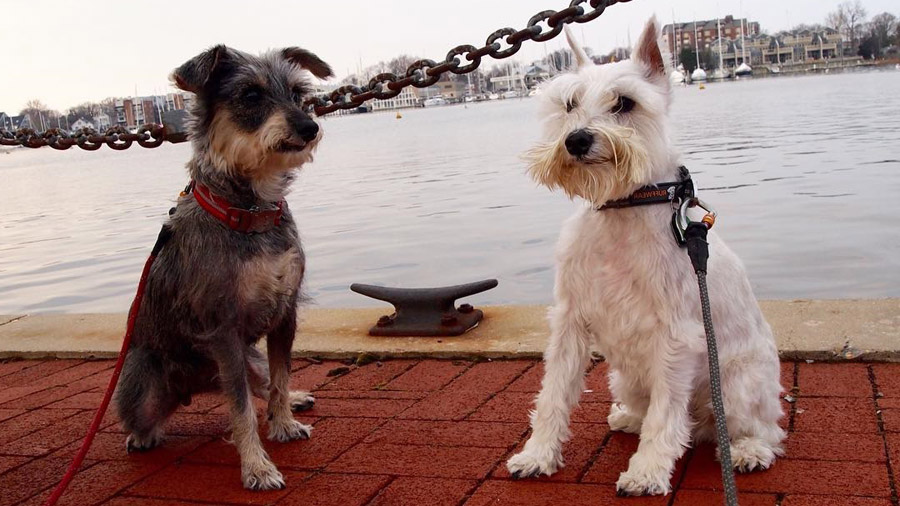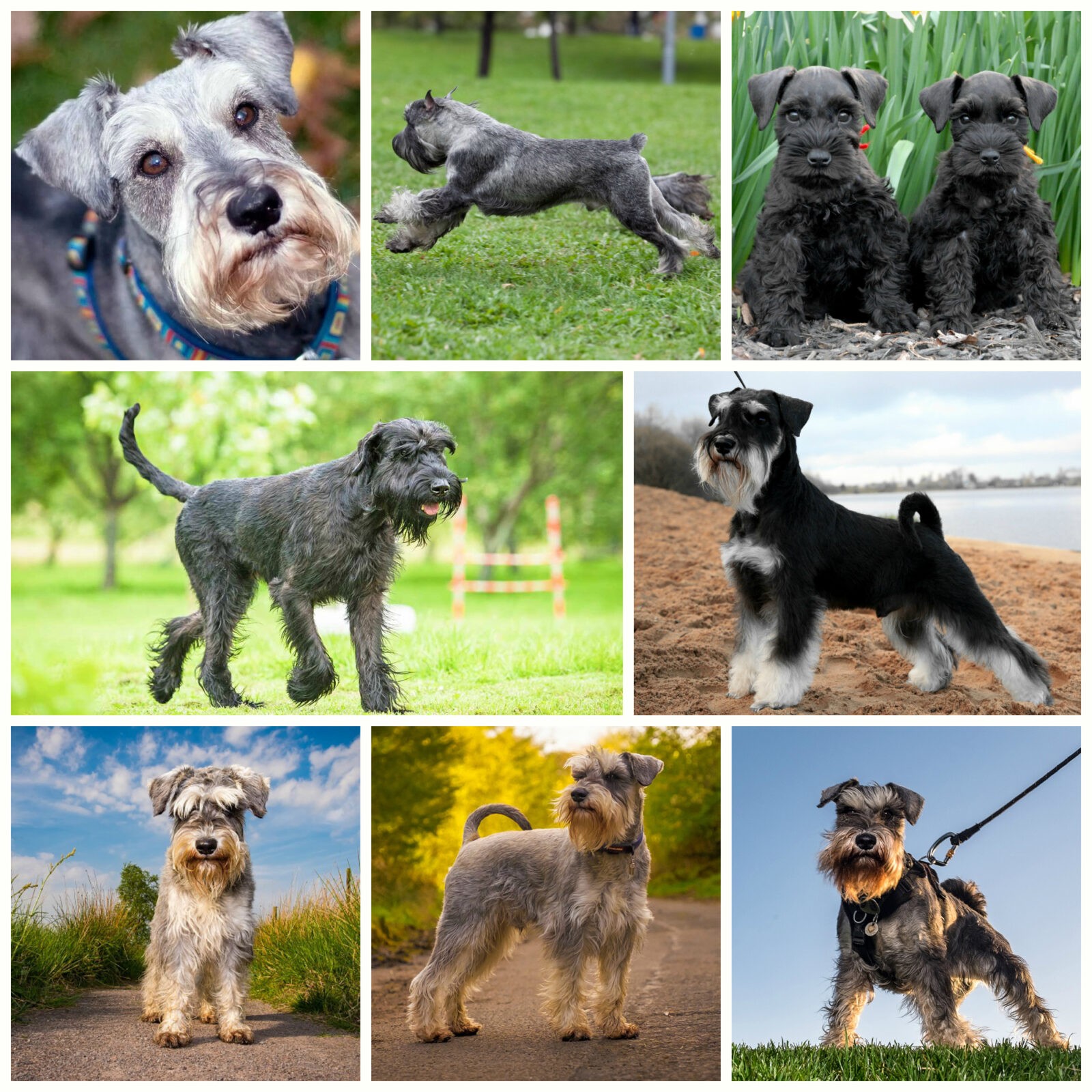
Brief description of the breed
All three breeds differ only in size, and the addition, as well as their character traits, are similar. All schnauzers are distinguished by an elongated head, a blunt muzzle, a flat forehead, semi-erect ears (which can be cropped), dark oval-shaped eyes, a muscular neck, without a hang, a square body, limbs are straight, strong, fairly wide set, the tail has a saber shape. Schnauzer coat is hard with a developed undercoat, on the eyebrows (the eyes should not be completely hidden by falling hair) and the beard is always elongated. The coat color is black (in miniature schnauzers sometimes with white markings in the muzzle, chest, inner abdomen, near the anus), pepper and salt (dark gray undercoat and relatively light gray coat), also in miniature schnauzers there is a white shade of wool.
basic information
| Breed name: | schnauzer |
| Country of origin: | Germany |
| The time of the birth of the breed: | 18th century |
| Type of: | pinscher and schnauzer |
| The weight: | 4 - 47 kg |
| Height (height at the withers): | 30 - 70 cm |
| Life Expectancy: | 12 - 15 years old |
|
ICF classification:
|
Group 2, Section 1, Number 181/182/183 |
| Puppies price: | 100 – 650 $ |
| Most popular nicknames: | list of nicknames for schnauzer |
Assessment of breed characteristics
| Adaptability
(a definition meaning how easily a dog can adapt to changes in life) |
🐶🐶🐶 |
| Shedding level
(Level and frequency of hair loss in the animal) |
🐶🐶 |
| Tenderness level
(The level and amount of tenderness and affection that the dog gives in return for attention to itself) |
🐶🐶🐶🐶 |
| Exercise needs
(Dog's daytime activity level) |
🐶🐶🐶🐶 |
| Social need
(The required number of contacts of the dog with other animals, as well as people) |
🐶🐶🐶🐶 |
| Apartment content
(A factor that determines the level of noise and other inconveniences that a dog can deliver to owners in relation to the size of the apartment to the size of the dog) |
🐶🐶🐶 |
| Grooming
(The number of bathing, brushing, and the number of professional grooming sessions required for the dog) |
🐶🐶🐶🐶 |
| Friendliness in an unfamiliar environment
(Features of the behavior of a dog in a society with strangers or in an unfamiliar environment) |
🐶🐶 |
| Tendency to bark
(Tendency to bark and its frequency and volume) |
🐶🐶🐶🐶🐶 |
| Health issues
(Potential health status of the dog) |
🐶 |
| Territoriality
(The dog's tendency to protect his home, yard, or even his owner's car) |
🐶🐶🐶🐶🐶 |
| Friendliness to cats
(The tendency towards tolerance for cats and decreased manifestation of hunting instincts) |
🐶🐶🐶🐶 |
| Intelligence
(The ability of the dog to think and solve emerging difficulties (not to be confused with learning!) |
🐶🐶🐶🐶🐶 |
| Education and training
(The level of difficulty in training the dog to perform certain actions) |
🐶🐶🐶🐶🐶 |
| Friendliness to children
(A factor that determines how friendly a dog is to children, whether he likes to play with them and tolerate some childish pranks) |
🐶🐶🐶🐶 |
| Game activity
(The concept is determined by its very name, and, as a rule, is found in almost all dogs) |
🐶🐶🐶🐶🐶 |
| Observation
(The ability of a dog to detect the presence of a stranger on its territory) |
🐶🐶🐶🐶🐶 |
| Friendliness to other dogs
(The tendency of the dog to find common language with his other relatives) |
🐶🐶🐶🐶 |
Schnauzer photo:

The history of the origin of the Schnauzer breed
The nature of the dog breed Schnauzer
Maintenance and care
Standard Schnauzers and Giant Schnauzers can live both in the apartment and in the yard (if there is an aviary and a warmed kennel). And miniature schnauzers, due to their small size, most often settle in apartments. In any case, the dog should have its own place where the bed, bowls for water and food, toys will be located.
Schnauzers need daily active exercise, especially when they live in an apartment, not being able to run in the open. But even dogs living in private or country houses need to be walked daily at least once a day for at least an hour. Active activities on walking grounds or in nature (in the forest, park, etc.) are suitable for them. Those dogs that do not have the opportunity to exercise daily, become aggressive, irritable over time, the lack of walks also affects the metabolism (obesity).
Wirehaired Schnauzers do not shed on their own, so the owner should teach the puppy to trimming from an early age in order to rid the animal of dead hairs. Trimming allows the schnauzer to acquire new hair, eliminates tangles, and has a beneficial effect on the skin and coat. Schnauzers should be brushed regularly, preferably every day (or at least a few times a week). Bathing dogs is best done as it gets dirty, but not more than 2-3 times a year. To wash a schnauzer, it is advisable to purchase a special shampoo for wire-haired dogs. Washing the paws after a walk, combing, attention to the condition of the eyes, watching the hair on the face after eating, examining and cleaning the ears and teeth - these are the simple moments during which the dog has a neat, well-groomed appearance.
Schnauzer nutrition can be both natural and industrial. Schnauzer owners often prefer premium and super-premium quality dry food for active dogs. In any case, you should not treat the animal with such dishes: sweet, fatty, spicy - in a word, everything that is not intended for quadrupeds.
Training and education of the Schnauzer breed
Schnauzer puppies should be subjected to early socialization, which will consist not so much in learning commands, but in getting used to life in the family and society. From the very beginning, the owner must show the dog that its role is of the second plan, that is, even a small puppy must be aware that the owner is not a toy, not his servant. You should not shout at the baby rudely, you should not beat, but in the process of education, when a schnauzer puppy shows aggression, bites, damages furniture or personal belongings of the owner, you can strictly talk to the animal or (in extreme cases) lightly push the rump with a twig. In order for the process of getting used to a new family and life to be successful, it is not bad to introduce elements of the game into the upbringing of a puppy, while not allowing the baby schnauzer to cross the line of what is permitted. These dogs learn easily and quickly when they are interested.
No matter which of the schnauzers we are talking about, all of them - tsvergs, mittels, and rizens require training. If the dog is started as a guard at home and a friend of the family, then it is a good idea to take a general training course. In some cases, schnauzers can successfully complete guard duty classes. It is better to entrust the training of these dogs to specialists in cases where the owner plans a show future for schnauzers, while domestic dogs that do not claim high ranks can be successfully trained in commands and obedience by the owner on their own.
Health and disease
Some interesting facts
- It is generally accepted that the most popular are medium-sized schnauzers - standard schnauzers. They perfectly show themselves as companions and bodyguards of a person, and as service dogs. The small size of the zwerg and the large dimensions of the rizens can lead to some difficulties in care and maintenance, while the mittels get along well anywhere, in almost any conditions. It is because of the greatest popularity of the standard schnauzers that they are called simply schnauzers or standard schnauzers.
- In the USSR, schnauzers appeared for the first time in the now distant 1979. The painstaking work of the metropolitan cynologists has made schnauzers popular human companions and excellent helpers for the police and the army. Today, Russian Schnauzers are the recognized leaders of the breed, holding the highest titles during competitions.
- At home, schnauzers are real favorites. Sayings are dedicated to them (“When the Lord distributed cunning, the schnauzer was the first”), they are immortalized for posterity (the monument “Night Watchman” of the 17th century in Stuttgart). And, probably, apart from Germany, there is no such country where schnauzers are unfamiliar to amateurs. dogs.
Nurseries and breeders
We borrowed material from the wonderful site of our partners DOGCATFAN.COM about cats and dogs, the author dogcatfan
